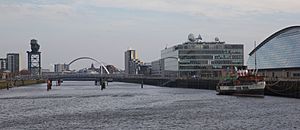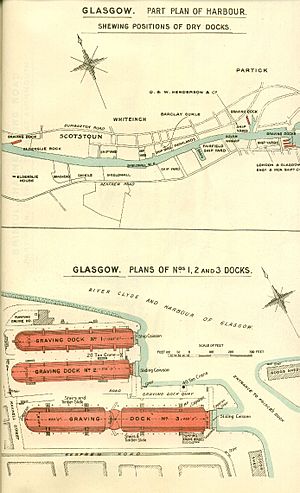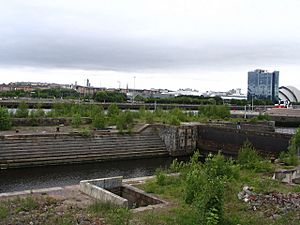Pacific Quay facts for kids
Pacific Quay is a cool area in Glasgow, Scotland. It's located on the south side of the River Clyde. This spot used to be a busy port called Princes' Dock Basin. It was the biggest dock on the River Clyde when it opened in 1900.
However, in the 1970s, fewer ships used the Upper Clyde. This was because of something called containerization. This new way of shipping meant huge containers were used, and they needed bigger ports. So, the Princes' Dock Basin stopped being a commercial dock.
Later, in 1988, the area became home to the exciting Glasgow Garden Festival. An old building called "Four Winds" is still there. It used to be a power station and pumping house for the docks. Today, it holds an engineering company and a radio station. The name 'Pacific Quay' was made up for marketing after the Garden Festival. It doesn't mean ships sailed from here to the Pacific Ocean!
Contents
What's at Pacific Quay Today?
Today, Pacific Quay is a modern hub with many interesting places. It's a great example of how old industrial areas can be given a new life.
Here are some of the main attractions and businesses you can find there:
- Glasgow Science Centre complex, which includes the tall Glasgow Tower.
- BBC Pacific Quay, the main building and studios for BBC Scotland.
- STV Group, the headquarters and studios for a Scottish TV channel.
- Capital Scotland, a popular radio station.
- Buro Happold, a company with expert engineers.
- Digital Design Studio, a research and business center from the Glasgow School of Art.
The Govan Graving Docks: A Look Back
Just west of Pacific Quay are the old Govan Graving Docks. A "graving dock" is a dry dock where ships can be repaired. Water is pumped out so workers can reach the bottom of the ship.
The first dock here opened in 1875. A second one followed in 1886, and the biggest one, which was 880 feet long, opened in 1897. These docks were very busy for many years, helping to fix ships on the Clyde.
The docks stopped being used in 1987. Since then, the site has been empty for a long time. There have been ideas to build homes or hotels there. However, these plans have not worked out.
Saving the Docks: A Community Effort
Many people want to save the Govan Graving Docks. They believe these docks are an important part of Glasgow's history. There is a campaign to restore them and create a maritime heritage park. This park would celebrate the city's shipbuilding past.
A group called the Clyde Docks Preservation Initiative was formed in 2015. They are working hard to protect the docks. They want to make sure the site is used to remember Glasgow's amazing shipping history. Many people have signed petitions to support this idea.
They have also shown that building houses on the site might not be the best plan. Instead, they hope the docks can be brought back to life as a place for everyone to learn about and enjoy Glasgow's rich maritime heritage.
See also
- Clyde Waterfront Regeneration
- Media Village Scotland




